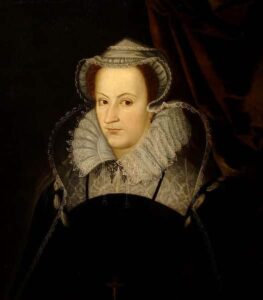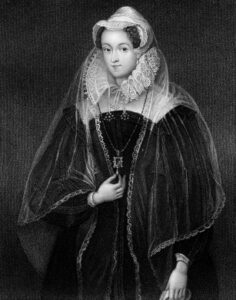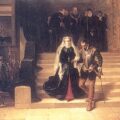
Today’s episode of BBC Radio 4’s Book of the Week on “Elizabeth’s Women” by Tracy Borman focused on Chapter 12 of the book – The “Bosom Serpent” – which details how Elizabeth I dealt with Mary Stuart (Mary Queen of Scots).
There were various plots and rebellions during Elizabeth’s reign that Mary Stuart was connected to. Mary Queen of Scots felt that she had a right to the English throne because she was a Tudor and she was not illegitimate like Elizabeth, and she allowed many revolts to go on in her name to challenge Elizabeth’s place on the throne.
Although the years following the Ridolfi Plot of 1572 were rather quiet, and Borman writes of how Mary seemed to be “more resigned to her captivity”, she was angered when her son, James VI of Scotland, rejected Mary’s request to rule alongside him as joint sovereign in 1583 and sided with Elizabeth. Mary was obviously very bitter and angry and Elizabeth’s ministers started to worry that once again Mary Queen of Scots would become involved in another plot to remove their queen. Elizabeth herself was also wary and referred to Mary as a “bosom serpent”.
Although Mary tried to reassure Elizabeth, saying that she wanted nothing but friendship between them, Elizabeth’s agents uncovered yet another conspiracy that had Mary’s name written all over it – the Throckmorton Plot. Unfortunately, there was no real evidence against Mary, so nothing could be done apart from removing her from the custody of the Earl of Shrewsbury, who was thought to have become to sympathetic to his prisoner, and place her in the custody of Sir Amyas Paulet.
In the summer of 1586, Elizabeth’s spymaster, Sir Francis Walsingham uncovered a plot by Sir Anthony Babington to assassinate Elizabeth and to replace her with Mary, as Queen of England, all with the backing of Spanish forces. Walsingham was able to intercept coded letters that Mary hid in beer barrels and he waited patiently for Mary to commit treason by mentioning the Queen’s death. On 17th July 1586, Mary Queen of Scots wrote to Babington supporting his idea that Elizabeth should be “despatched” and ordered him to get on with it. This was the evidence that Walsingham had been waiting for and in August 1586 Babington and other conspirators were tortured into confessing to both the plot and Mary Stuart’s involvement in it. There was now evidence that Mary had committed treason, not just by mentioning the Queen’s death but by ordering it.
The Signing of the Warrant

Mary may have been a traitor but Elizabeth was concerned about the backlash that Mary’s execution would cause, putting England under threat from Spain and France, but more importantly Mary Stuart was an anointed Queen and she was a Tudor.
Elizabeth wavered over signing the death warrant because she found it so hard to come to terms with killing another queen.
She said:
“What will they now say that for the safety of her life a maiden Queen could be content to spill the blood even of her own kinswoman?”
Tracy Borman also makes the point that Elizabeth may have found the idea of executing Mary so abhorrent because she finally realised what Mary had been talking about in her past letters when she had written of female solidarity, “our sex in common”. Elizabeth may also have thought about her own mother’s execution. All of this guilt and worry was preying on the Queen and she was being pressurised, and even bullied, by her council to sign the warrant and get rid of the woman who had plagued her for so long.
Mary preyed on Elizabeth’s feelings (as you would if you think you’re going to be executed!) by sending her a letter mentioning Henry VII, “your grandfather and mine”, and saying:
“When my enemies have slaked their black thirst for my innocent blood, you will permit my poor desolated servants altogether to carry away my corpse, to bury it in holy ground, with the other Queens of France, my predecessors, especially near the late queen, my mother.”
Elizabeth was so worried about signing the warrant that Borman writes of how she even asked Paulet to “ease her of this burden” by dispatching Mary with poison or something. Paulet refused and Elizabeth was left with no choice but to sign the warrant.
Historians today still debate the story of what happened next and the story that Elizabeth told after hearing of Mary’s execution differed from that of her secretary William Davison’s story. According to Elizabeth, she signed the death warrant but ordered Davison not to issue it until she ordered him to do so. However, Davison said that he took the warrant to Elizabeth, along with other papers, and she signed it knowing full well what it was for and then ordered him to dispatch all of the papers. She also told him to seal the warrant before it was given to the Lord Chancellor and then asked him to tell Sir Francis Walsingham that she had given in to all of her advisers’ pressure and had signed the warrant.
Davison waited two days before presenting the warrant to the council, in case the Queen should change her mind, and during this time the Queen apparently said to him that she had no regrets about signing the warrant, even though she had had a troubling dream about Mary. Davison, therefore, went ahead and presented the warrant to the Queen’s council where it was decided to dispatch it to Fotheringay. Some historians write of how each member put their name to the warrant so that if Elizabeth did indeed change her mind and blame her council, all of them were equally liable, but Borman does not write of this.
The Execution
On the 8th February 1587, Mary Queen of Scots was executed at Fotheringay Castle. Theatrical and dramatic to the end, as she took off her outer gown she displayed a bright scarlet gown, the colour associated with martyrs – Mary felt she was dying as a martyr of the Catholic Church and wanted the whole world to know this.
In her book, Borman writes of how this woman, who was once famous for her beauty, was now described as “round shoulder’d, of face fat and broad, double chinned and hazel eyed: borrowed hair” and how it took three blows of the axe to kill her. Also, when the executioner lifted Mary’s head he was left holding just the wig and then there was a movement under her gown as her little dog, who had been hiding there, scurried out and “laid itself down betwixt her head and body”. The story of Mary’s awful execution must have weighed heavily on Elizabeth.
Elizabeth’s reaction to news of Mary’s execution was to fly into a rage, screaming that she had never ordered it. William Davison was stripped of his office, flung into the Tower, interrogated and fined £10,000, while ten of Elizabeth’s councillors were ordered to appear before the Archbishop of Canterbury, the Lord Chief Justice and the Lord Chancellor to explain themselves. Even Lord Burghley was in “deep disgrace”.
Borman writes of how Elizabeth’s rage was probably a combination of sorrow at Mary’s death and resentment that her council had bullied her into making a decision that she just did not want to make.
The Aftermath
Elizabeth’s fears of reprisals after Mary’s execution were soon realised as Philip of Spain launched his Armada against England in Mary’s name. However, Borman writes of how Elizabeth was able to turn this situation around and that England’s defeat of the Spanish Aramada was responsible for transforming Elizabeth’s “image into one of invincible majesty” and that this was thew start of the legend of “Gloriana”.
After Pope Sixtus V heard of Elizabeth’s victory, he said:
“She is only a woman, only the mistress of half an island, and yet she makes herself feared by Spain, by France, by Empire, by all!”
Not only did Elizabeth manage to rise from being just a “mere woman”, but she also managed to become “divine”. She wasn’t just God’s chosen one, his representative on Earth, Borman writes of how Elizabeth believed that she was a divine Virgin Queen, the Virgin Mary, who had powers beyond those of normal humans. In her 1601 Golden Speech, Elizabeth referred to having “the glorious name of a King” but the “royall authoritie of a queene”, and Borman believes that it is this interchanging of imagery, between king and queen and man and woman, that Elizabeth used on many occasions, that:
“set her apart from all her predecessors – kings and queens alike – and created a unique identity that would assume iconic status both during her own lifetime and over the centuries that followed.”
Elizabeth I has indeed gone down in history as an iconic Queen, a Gloriana or mythical goddess, who held the love of her people and mad England a strong and prosperous country once again.
Further Reading
This article is a precis of today’s episode of BBC Radio 4’s Book of the Week featuring “Elizabeth’s Women: The Hidden Story of the Virgin Queen”, and my own reading of Chapters 12 and 13 of the book. “Elizabeth’s Women” has just been released in the UK and you can click here to find out more about ordering it from Amazon UK who ship worldwide.









